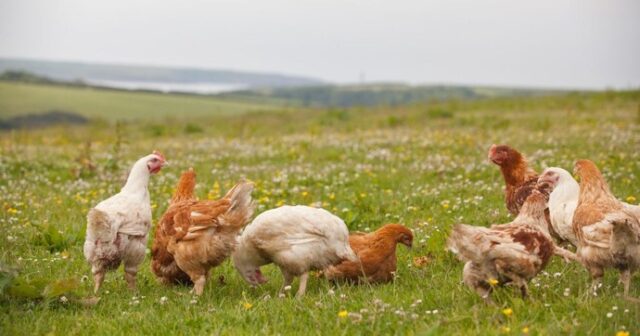Poultry is the most organized sector in animal agriculture, estimated to be worth approximately rupees one lakh crores. India is the third-largest producer of eggs (after China and the USA) and the fifth largest producer of broiler meat in the world (after the USA, China, Brazil, and Mexico). Increased poultry production during the last four to five decades was possible largely because of a fundamental change in the viewpoint of both, the planners and farmers. Eggs and chicken were ‘agriculture produce’a few years ago but are ‘food items’ today. Besides maintaining the production efficiency, producers have to concentrate on the nutritive values, adulterants, and contaminants of their produce. Food safety is very important. Over the last decade, due to increased health awareness and consumer preference, organic farming increased gradually throughout the world. Organic farming maintains soil-plant, plant-animal, and animal-soil interdependence and produces a sustainable agroecosystem based on local resources (Biradar et. al, 2011). The time interval between the start of organic management on the farm and certification of the farm and its products is known as the conversion period’.
In the USA, organic meat sector, especially the poultry meat sector, is growing very rapidly. Chicken meat is the most important organic meat due to its short production cycle and low cost as compared to other livestock meat. The poultry population of India is large (˃ 729.21 million), indicating there may be vast scope for organic farming in the export market. Consumers are progressively becoming more aware of the safety and quality of food products consumed by them. Further, as purchasing power (PP) of common people is increasing persistently, they are interested to consume safer products without bothering to pay more. So, the production of safer poultry products without any chemical and microbial residues is the order of the day. On the other hand, the emerging importance of animal (poultry) welfare started showing its adverse implications for trade at the international level, as there is a growing argument that intensive cage rearing, forced moulting, etc., are unethical practices and against animal welfare. Therefore, laying greater emphasis on organic poultry farming can help us produce safer poultry products without compromising animal (poultry) welfare.
Organic livestock farming is most suitable to our Indian conditions because of indigenous technical knowledge and practices followed by Indian farmers. To make organic livestock and poultry farming successful, there is a need to take care of certain issues, like health management, record keeping, breeding strategies, certification, cost of production, and cost of inputs. Indigenous/ local breeds or breeds developed with organic and free-range systems may be used for organic poultry farming. Breeds developed by different organizations for rural poultry farming, having better performance, can be used for the organic poultry production e.g., Vanaraja, Giriraja, CARI Gold, CARI Nirbhik, CARI Shayama, CARI Hitcari and Nico- rock. Natural breeding methods should be used. To improve fertility, A.I. can be used under the guidance of a technical or a veterinary expert. Any hormonal treatment to improve growth and egg production should be avoided.
Appropriate housing that permits natural behavior, including outdoor access, is essential. House should be well ventilated, have solid walls, be raised three feet from the ground with chicken wire fitted up to the roping base to avoid direct wind droughts into the poultry house. Housing should be designed to maximize natural light. The foraging area can be constructed entirely of poles and chicken wire on walls and roads. Some open areas with plants and grasses, which provide green forage to the birds, should be developed near to poultry house. An adult layer bird in an organic system should be provided with a minimum area of 2ft./ bird in the confined area and 3ft./ bird as foraging area i.e., 5 sq.ft./ bird. Sufficient feeding and watering space (4-5 cm/ bird for feeding and 3-4 cm/ bird for watering) should be provided to the birds to reduce competition among birds.
Poultry must be fed a diet that contains a minimum of sixty percent certified organic feed. Organically reared birds need 20-50% more feed per unit of weight gain than conventionally reared birds, mainly because of increased activity in the run. The average feed consumption in an organic production system for layer and broiler are 130 gm and 85 gm, respectively, whereas in a conventional production system, the average feed consumption is 118 gm and 77 gm.
Organic animal husbandry does allow routine vaccination where there is an urgent need, but other methods of treatment can be regarded as less acceptable. Feeding probiotics is beneficial to the health of the birds as it reduces the number of foodborne pathogens. Prebiotics are non-digestible carbohydrates and many of them may be used for improving the health status of poultry birds. Various plant extracts especially essential oils have been tested for their anti-microbial abilities. Some essential oils like oil of black paper, essential oil of cinnamon, garlic oil, etc. are found to benefit towards the improvement of some aspects of digestibility of poultry birds.
In a true sense ‘livestock revolution’ aims not merely to increase the quantum of production but to have a holistic approach towards improved food security and safety of consumers. India has tremendous potential in organic poultry production as a large part of the country is organic by default. What we need today is the necessary institutional policy framework that can pave the way for the promotion of organic poultry farming in particular and organic livestock farming in general on a nationwide scale.

Oshin Togla1, Shivam Bhardwaj1, Ymberzal Koul1
1Animal genetics and breeding division, NDRI, Karna















